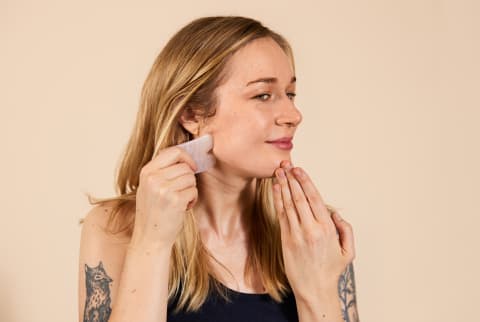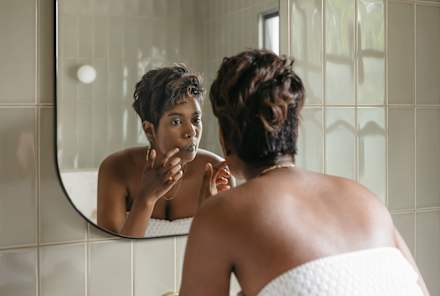Advertisement
Gua Sha Review: What 2 Weeks Of Gua Sha Did To My Skin + How to Do It Yourself

If you've spent time on any social media channel—be it Instagram, TikTok, or another—you've probably seen a gua sha stone.
The pretty slabs of crystal are far more than just a trendy skin care ritual beloved by wellness influencers and beauty gurus: Facial gua sha is a specific type of massage adapted from ancient Chinese bodywork that utilizes a scraping tool to encourage circulation and lymph flow.
And to learn more about how to cultivate a daily practice, I tapped New York City's gua sha expert and mindbodygreen collective member Britta Plug. She tells me long-term results from facial gua sha rely heavily on consistency and self-practice.
Here's the play-by-play of doing gua sha every morning for two weeks. (And if you want to learn more about gua sha, check out the explainer here.)
My 2-week review of daily gua sha facials
Stage 1: At first, I broke out a little bit.
Not exactly what you'd expect from a skin-soothing treatment. "It's like stirring up the muck from the bottom of a lake," said Plug. If you're starting any kind of facial massage regimen, whether it's gua sha or another type of lymphatic drainage, breakouts can occur. "But don't stop the regimen," Plug said.
If you, too, start to notice breakouts on your face after trying a few consecutive days of gua sha, she suggests focusing on downward strokes starting from the jaw line and ending at the clavicle. (An editor's note: The jury's still out on how well gua sha can encourage lymphatic drainage—as there hasn't been a ton of studies on it—regardless, encoring circulation to the face is good for the skin.)
Stage 2: I became intimately acquainted with how my face holds stress.
I thought I'd come to know my facial tension through a daily practice of oil cleansing and massage, but it turns out that running a flat stone over the contours of your face gives you far more nuanced information.
You can feel the peaks, valleys, divots, and—dare I say?—knots in your face with a gua sha stone. I tend to hold tension under my cheekbones, forehead, and all along the side of my face, from the temple to the jaw line. When I worked on my forehead lines, feeling the specific shape of the tissue underneath the skin told me volumes about how I express and hold my face. Knowing this, I became more aware of my facial muscles in general.
So often people talk about knowing how you hold your body—but we should also be aware of how we hold our face. Regular facial massages can help us do that.
Stage 3: I started to pay more attention to my neck.
Plug advocates that anyone starting a self gua sha practice should start (and often finish) with neck work. "And not just the gentle lymphatic drainage strokes," she said, "but you can work with more pressure with tight muscles in the back of the neck too. They all act as roadblocks to lymphatic drainage."
After a few days of consecutive gua sha, I noticed a little swelling underneath my jaw line and chin. Plug said that the lymph might be pooling in that area. If you find that happens for you, "neck work is even more important," she said. "Start and finish with gentle strokes down the neck to keep the lymph moving."
Note
Stage 4: My face became more "sculpted" looking.
As gua sha is often touted as "natural Botox," I was hoping to focus on easing up of my forehead lines. I have deep fine lines in my forehead and always have. I used the "eraser" technique, wherein you hold the skin around the forehead lines taut and, like a pencil eraser, take the stone at 90 degrees and shimmy it over the wrinkle.
After a while, I didn't really care about the aesthetic results—relieving that kind of tension felt so good.
For me, the lines looked smoothed right after my self-practice, but so far they still return. "Because of the shape of your forehead, your lines go a little deeper," Plug said.
The eraser technique will help break through scar tissue that's formed, but it's a longer process. "Someone who has a different shape or surface lines might see results more quickly," she said.
Overall, I have noticed that my skin looks more sculpted, lifted, and buoyant. It has a bounce that sticks around all day long, and that awake, pulled-back look I didn't realize I could give to myself.
Stage 5: I felt more energized.
Doing gua sha first thing in the morning was the only way I could ensure it would happen. Otherwise, it felt like a chore at the end of the night, one I was unlikely to do if I was too tired. Slowing down first thing in the morning didn't come naturally. In fact, it took me by surprise how much I had to tell myself to slow down with each stroke, to tune into the sensations underneath my skin, and to breathe through it.
Getting over that go-go-go mentality was, ironically, the very thing I needed to feel energized throughout the day. When self-care is one of the first things I do, I'm able to build on that momentum and serve everyone and everything else with my full attention.
A three-step guide to starting (and keeping) your own practice
If you're starting your own gua sha practice, here are Plug's top three tips for making the most of your facial gua sha:
Build a structure around your practice
As with any practice, you're more likely to stick with it if there's a built-in routine. Start by picking a time of day that works for you (Plug's advice: The best time of day for gua sha is the one you'll stick with). Work in essential oils, burn some sage, or anything else that brings the energy you're looking to cultivate.
Start slow
Especially if you tend to have reactive skin, it can be tempting to "go hard" or fast, but listen to your skin and be gentle with yourself. If you notice breakouts or anything starting to come to the surface, don't stop the gua sha—focus on the neck work until your face starts to calm down. Unblocking the neck is a huge and often overlooked part of the gua sha practice!
Listen to your body
As you'll likely become much more in-tune with the muscles in your face, me mindful of how you hold them throughout the day. One of the most important parts of a facial massage routine is self-awareness, so take that with you throughout the day. For example, when you feel yourself tense up, take a moment to pause.












